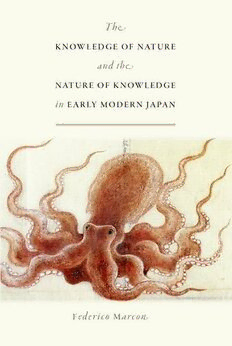
The Knowledge of Nature and the Nature of Knowledge in Early Modern Japan PDF
Preview The Knowledge of Nature and the Nature of Knowledge in Early Modern Japan
Knowledge of Nature The Nature of Knowledge and the Early Modern Japan in Studies of the Weatherhead East Asian Institute, Columbia University The Studies of the Weatherhead East Asian Institute of Columbia University were inaugurated in 1962 to bring to a wider public the results of significant new research on modern and contemporary East Asia. Knowledge of Nature The Nature of Knowledge and the Early Modern Japan in Federico Marcon The University of Chicago Press Chicago and London Federico Marcon is assistant professor of Japanese history in the Department of History and the Department of East Asian Studies at Princeton University. The University of Chicago Press, Chicago 60637 The University of Chicago Press, Ltd., London © 2015 by the University of Chicago All rights reserved. Published 2015. Printed in the United States of America 24 23 22 21 20 19 18 17 16 15 1 2 3 4 5 ISBN- 13: 978- 0- 226- 25190- 5 (cloth) ISBN- 13: 978- 0- 226- 25206- 3 (e- book) DOI: 10.7208/chicago/9780226252063.001.0001 Library of Congress Cataloging-in-Publication Data Marcon, Federico, 1972– author. The knowledge of nature and the nature of knowledge in early modern Japan / Federico Marcon. pages cm Includes bibliographical references and index. isbn 978-0-226-25190-5 (cloth : alkaline paper) — isbn 978-0-226-25206-3 (ebook) 1. Nature study—Japan—History. 2. Science—Japan—History. 3. Japan— History—Tokugawa period, 1600–1868. I. Title. qh21.j3m7 2015 508.52—dc23 2014047538 ♾ This paper meets the requirements of ANSI/NISO Z39.48- 1992 (Permanence of Paper). A philosophical interpretation of world history would have to show how the rational domination of nature comes increasingly to win the day, in spite of all deviations and resistance, and integrates all human characteristics. — Max Horkheimer and Theodor W. Adorno Contents Prologue ix Part I. Introduction 1 Chapter 1 Nature without Nature: Prolegomena to a History of Nature Studies in Early Modern Japan 3 Chapter 2 The Bencao gangmu and the World It Created 28 Part II. Ordering Names: 1607– 1715 51 Chapter 3 Knowledge in Translation: Hayashi Razan and the Glossing of Bencao gangmu 55 Chapter 4 Writing Nature’s Encyclopedia 72 Chapter 5 The First Japanese Encyclopedias of Nature: Yamato honzō and Shobutsu ruisan 87 Part III. Inventorying Resources: 1716– 36 111 Chapter 6 Tokugawa Yoshimune and the Study of Nature in Eighteenth- Century Japan 115 Chapter 7 Inventorying Nature 140 Part IV. Nature’s Spectacles: The Long Eighteenth Century (1730s– 1840s) 153 Chapter 8 Nature’s Wonders: Natural History as Pastime 161 Chapter 9 Nature in Cultural Circles 179 Chapter 10 Nature Exhibited: Hiraga Gennai 207 Chapter 11 Representing Nature: From “Truth” to “Accuracy” 228 Part V. The Making of Japanese Nature: The Bakumatsu Period 251 Chapter 12 Bakumatsu Honzōgaku: The End of Eclecticism? 255 Chapter 13 Nature as Accumulation Strategy: Satō Nobuhiro and the Synthesis of Honzōgaku and Keizaigaku 276 Epilogue 299 Acknowledgments 307 List of Japanese and Chinese Terms 309 Notes 329 Index 397 Prologue ........... The Sanjō Guest House, where I spent the summer of 2013, is located in the middle of the Hongō campus of Tokyo University. It stands near a gar- den, the Ikutokuen, which was built in the 1630s in what was then the Edo residence of the powerful Maeda Toshitsune, domainal lord (daimyō) of one of the wealthiest regions of Tokugawa Japan, Kaga.1 The garden expands around a pond shaped like the character 心, or kokoro (“heart- mind”), today known by most as “Sanshirō’s pond” (Sanshirōike) from the name of the protagonist of Natsume Sōseki’s novel.2 The vegetation around the pond is so exuberant that one cannot help but perceive a sense of disordered and disquieting wilderness. At least, that is what I usually felt when I walked the narrow and uneven paths around the lake. It is populated by a variety of birds: crows, cuckoos, thrushes, woodpeckers, ibises, kingfishers, bushwarblers, rufous turtledoves, and a bevy of green parrots. One night I even met a Japanese raccoon dog (Nyctereutes pro- cyonoides viverrinus), or tanuki, as it is called here, protagonists of a mass of folktales that describe them as creatures endowed with supernatural powers— mischievous tricksters, masters of disguise, often portrayed with portentously huge testicles. At a closer look, however, the disordered luxuriance of the garden is far from being a sign of its wilderness. In the trunk of many trees and among short herbs, in fact, one can spot plastic labels with the names of many of the plants growing there. These tags catalog the vegetation of the garden in a precise inventory of its natural riches. They represent an odd contrast with the first impression of wilderness it gives. They suggest design, planning, artifice, and, most important, dominion over nature. If you visit the parks of Tokyo in search of an improb- able relief from the sultriness of Japanese summer, you will have the same odd experience: a sense of disordered wilderness that vanquishes as soon as you no- tice labels bearing the name of trees and herbs, sometimes with even the Latin scientific name attached. Knowledge of the natural world is as old as human beings. Information on the nutritional, curative, and venomous properties of plants constituted a matter of life or death for early Homo sapiens. Even today, biologists routinely use the “bo- tanical” knowledge of tribes of hunter-g atherers in Southeast Asia, Africa, and South America to explore the remotest recesses of the last surviving rainforests. But the kind of knowledge natural sciences like botany and zoology produce ix
